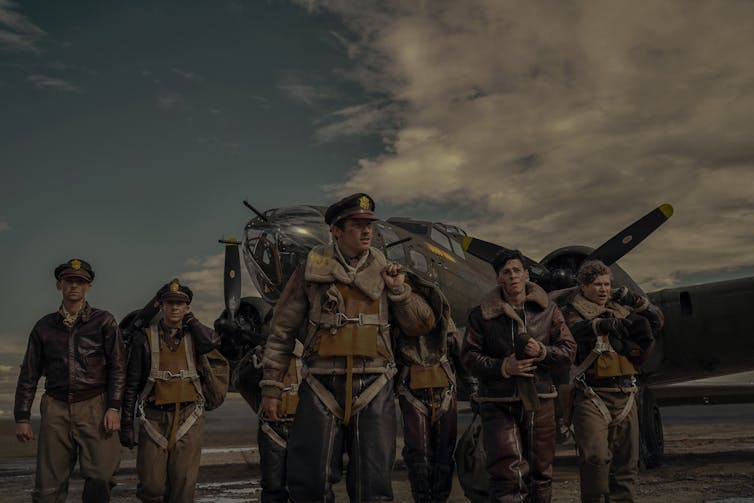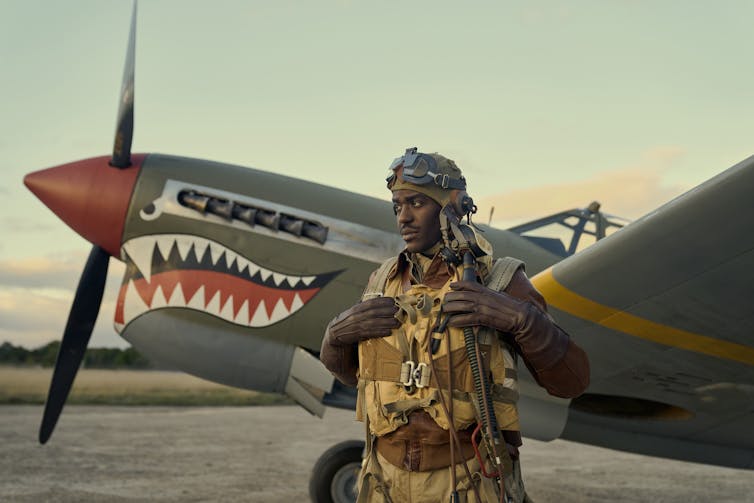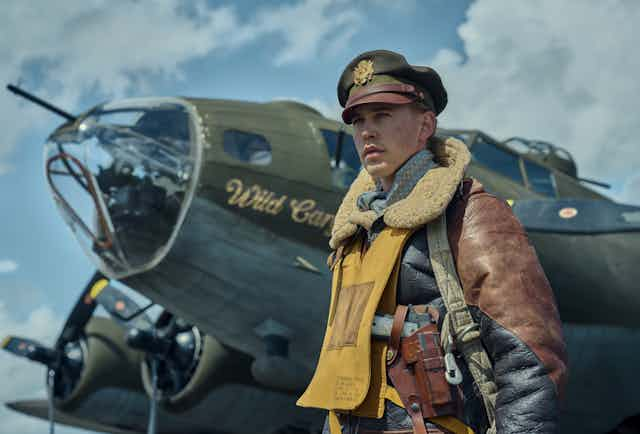Apple TV’s new second world war series, Masters of the Air, tells the story of the 100th Bomb Group of the US 8th Air Force, which operated B-17 “Flying Fortress” bombers from an airfield at Thorpe Abbotts in Norfolk. The series is based on Donald L. Miller’s history book of the same name and is produced by Stephen Spielberg and Tom Hanks.
As a historian with interests in the history and memory of the 8th Air Force, I was largely impressed by the show’s historical accuracy, especially the recreation of the base at Thorpe Abbotts. The series delivers a moving portrayal of the American bomber boys and explores their role in the European air war with care and sensitivity.
But there are also missed opportunities, and the storytelling lacks the confidence and clarity of previous Spielberg-Hanks productions.
The European air war
Like many of its cinematic predecessors, Masters of the Air examines the doctrine employed by the 8th Air Force – daylight precision bombing. Focused on the “choke-points” in the German war economy – oil refineries, fighter production, ball-bearing manufacture – it was a key point of divergence with Britain’s Royal Air Force which attacked German industry through nighttime “area” bombing.
The merits of each approach are dealt with early on: an argument with RAF aircrew in the pub leads to fisticuffs and the matter is duly settled with one swift punch (in the favour of the Yanks).
The necessity of daylight precision bombing asserted, the series turns its attention to its cost in aircraft and aircrew. Missions are launched, and fortresses fall. Young aircrew bravely and stoically endure.
Air combat, we are shown, is brutal and chaotic. It consumes energy, sanity, hope. It breaks minds and bodies. In confronting the sheer arbitrariness of life and death, survival and sacrifice, Masters of the Air is a worthy successor to the Gregory Peck film, Twelve O’Clock High (1949).

Missed opportunities
The series pivots around real legends of the 100th Bomb Group, including Major Gale “Buck” Cleven (Austin Butler), Major John “Bucky” Egan (Callum Turner) and Major Robert “Rosie” Rosenthal (Nate Mann).
The nine episodes follow their war from rural East Anglia, to the skies over Germany, to the fields and forests of the European countryside and to the Stalag Lufts in which some were interned as prisoners of war. This enables the series to explore subjects that might otherwise have been absent: the bravery of European resistance fighters, the impact of Allied bombs on civilians, the crucial role played by Allied espionage and the brutality of the war in the east.
The result is a rich story which avoids an overly repetitive format based purely on bombing missions. But there are consequences.
One is that the series gives relatively little space to exploring the deep bonds between aircrew and East Anglians. This is a shame given the important role long played by the latter in zealously guarding the 8th’s memory.
Another is the portrayal of racial segregation, the official wartime policy of the US military, which was not ended until 1948. A product of contemporary racism, this policy placed all African American personnel into separate units, and it restricted the vast majority to non-combat roles.
Military segregation is acknowledged in Masters of the Air through the story of the Tuskegee Airmen, as the African American pilots of the 99th Pursuit Squadron and 332nd Fighter Group were known.
The only African American units to fly in combat, they served with distinction in North Africa, Sicily, and Italy. As such, it it is absolutely right that Tuskegee Airmen like Alexander Jefferson (Branden Cook), Richard D. Macon (Josiah Cross) and Robert H. Daniels (Ncuti Gatwa) feature in the series.

At the same time, though, a parallel history more local to the 8th Air Force in England is overlooked. There were approximately 150,000 African Americans based in Britain during the war, of which around 12,000 were in eastern England working tirelessly in logistics and supply. Like the Tuskegee Airmen, all were subject to the indignities and institutional racism of military segregation.
Masters of the Air misses the opportunity to acknowledge their service too.
An uncertain future
This is indicative of a broader issue. For all its stirring soundtrack (Blake Neely’s score certainly makes the spine tingle) the series lacks the power and punch of previous Spielberg-Hanks work.
Band of Brothers – with which the series will inevitably be compared – was made in the halcyon days of the turn of the 21st century. This was the moment, the decade between the end of the Cold War (1991) and 9/11 (2001), when the second world war became firmly established in American culture as the “Good War”.
The conflict retains this sheen in the American imagination, and Masters of the Air is in thrall to the “greatest generation”. But after the inconclusive “war on terror” and the chaotic US withdrawal from Afghanistan, and amid the ongoing Russian invasion of Ukraine, the series is also the product of a very different moment – one far less sure of the future.
In a sense, this brings to the series a heightened authenticity. After all, Harry Crosby (Anthony Boyle), the series’ narrator, explicitly confronted the lingering uncertainties of his war experience in his powerful memoir, A Wing and Prayer (1993) in which he explains how he “learned to live with ambiguity”. Just as importantly, though, such uncertainty marks Masters of the Air as inescapably of its time.
This was powerfully revealed on the very day the first two episodes were released (January 26), when it was reported that a modern US airbase in East Anglia – RAF Lakenheath – was being readied to potentially host nuclear weapons.
This is a decision inextricably linked to the events in Ukraine. But it also implies that the peace won by the “Bloody 100th” all those years ago – from an airfield just 40 miles away – is more fragile than it has been for quite some time.

Looking for something good? Cut through the noise with a carefully curated selection of the latest releases, live events and exhibitions, straight to your inbox every fortnight, on Fridays. Sign up here.

